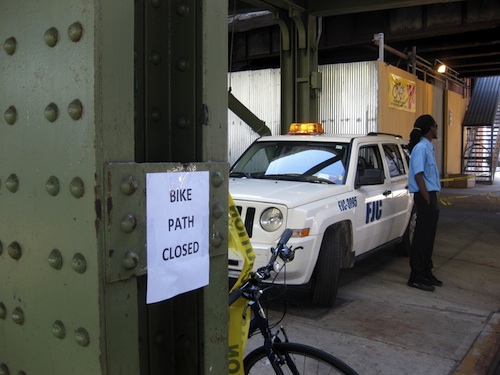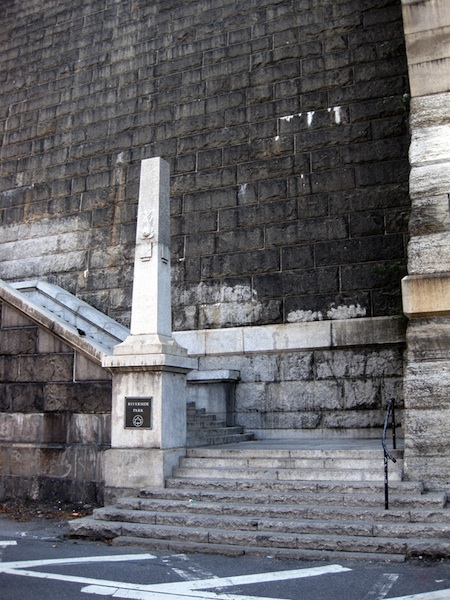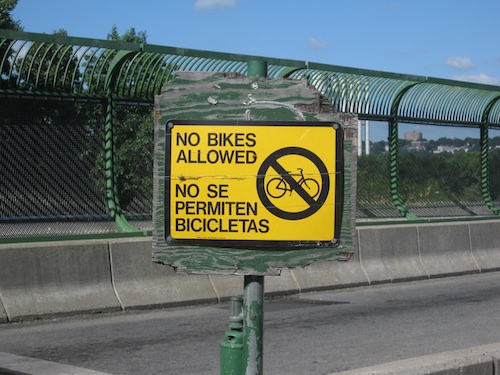
The Hudson River Greenway is the most heavily used bike path in the United States, carrying roughly one-seventh of all cyclists entering Manhattan below 50th Street. In Upper Manhattan, where there are fewer bike lanes and much less on-street protection for cyclists than further south, it is truly the backbone of the bike network.
Despite the greenway's centrality to the city's bike network, a ten-block stretch of the path between 135th and 145th Streets has been closed for a week, with scarce effort to provide an alternative route for cyclists and other park users.
Last Wednesday, a fire at the North River Wastewater Treatment Plant forced that plant offline, sending untreated sewage from Manhattan's entire West Side directly into the Hudson. As part of its round-the-clock repairs, the city Department of Environmental Protection closed the greenway where it runs in front of the plant. A DEP spokesperson said that the greenway was closed to allow for emergency responder access, but would not elaborate further.
The plant is separated from the street grid by both train tracks and the West Side Highway, so it's not implausible that the greenway space is needed for vehicle access or staging. I did not, however, see any vehicles, emergency or otherwise, on that stretch of the greenway this morning. Since the area in front of the wastewater plant was restricted, it was difficult to get a good view of the entire closed-off greenway segment and what it's being used for.
As I learned when I rode my bike up to the area to investigate, the closure forces cyclists heading north or south on the greenway into a confusing, time-consuming, and potentially dangerous detour without any sort of signage or guidance.

I started out riding north on the greenway this morning to investigate. Between 125th Street, where I entered the greenway, and 135th Street, there was no warning of any impending detour. Only when I reached the yellow tape blocking off the path was I alerted. There a single sheet of paper read, "Bike Lane Closed."
A security guard told me that I should detour east on the remaining half-block of 135th Street but did not know what to do after that. It turned out there were two options involved, neither of which were indicated by any kind of sign: looping back south and then cutting east to Broadway, or climbing roughly four stories worth of stairs up to Riverside Drive. Since Riverside is relatively low-traffic and marked as a bike route, I chose the stairs.
Biking north on Riverside, there are no signs alerting cyclists where they can cross over the tracks and the highway back onto the Greenway; you have to either ask around or already know. The first crossing that doesn't seem forbidden comes at 148th Street. Again, it's stairs all the way down.
Northbound cyclists can cross with a bit more ease, at least while the detour is in effect, by using a ramp at the 145 Street entrance to Riverbank State Park. But cyclists on Riverside Drive are greeted at the park entrance with a bright "No Bikes Allowed" sign, sure to keep most from trying to use it as a crossing.

While the greenway is closed, a park ranger told me, cyclists will be allowed to use this ramp and walk their bikes through the park. This concession was only given grudgingly. The ranger said just yesterday state park officials asked the city to send cyclists up the steps at 148th Street rather than through their park.
For cyclists riding the other direction on the greenway, the detour directs you to an elevator up to Riverbank Park, from which you can cross the ramp back onto Riverside, though no directions for what comes next are available.
Headed south on Riverside, cyclists can access the greenway at 125th Street, and again the signage is non-existent and the loops required to make it down to the water aren't intuitive unless you know the area.
For cyclists, the effects of this detour are substantial, and Streetsblog has received several messages from long-time city cyclists and new bike commuters about their experiences. Those who depend on the car-free greenway for safety and comfort are thrust without warning onto Manhattan streets. Once on those streets, there is no indication of how to get back to the greenway and no alternative protected route.
DEP said they do not yet have a timeframe for when the greenway will be reopened. Until it is, they need to work with the Parks and Transportation Departments to provide clear guidance for how cyclists ought to detour, just as would happen were a major road closed for any substantial amount of time.





